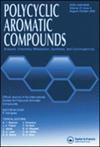1H-1,2,3-三唑连接喹啉-酚类天然产物共轭物的合成与抗菌评估
IF 2.6
3区 化学
Q2 CHEMISTRY, ORGANIC
引用次数: 0
摘要
利用铜(I)催化的叠氮-炔烃[3 + 2]环加成反应(CuAAC...本文章由计算机程序翻译,如有差异,请以英文原文为准。
Synthesis and Antimicrobial Evaluation of 1H-1,2,3-Triazole-Linked Quinoline-Phenolic Natural Product Conjugates
A new library of quinoline–natural product conjugates bearing 1,2,3-triazole moiety as a linker has been synthesized using the copper(I) catalyzed azide-alkyne [3 + 2] cycloaddition reaction (CuAAC) methodology. The structure characterization of the synthesized compounds was achieved using NMR and HRMS analysis. The compounds were subsequently screened for their antimicrobial efficacies against methicillin resistant Staphylococcus aureus (MRSA), MDR Klebsiella pneumoniae, Acinetobacter baumannii, Pseudomonas aeruginosa, Escherichia coli, Candida albicans, and Cryptococcus neoformans. The studied compounds generally displayed stronger inhibition of microbial cell growth compared to their parent phenolic natural products. Eugenol, thymol, guaiacol, and o-vanillin based 1H-1,2,3-triazole compounds exhibited the best antimicrobial profiles while the pathogen, A. baumannii showed the highest susceptibility to the hybrids. Precisely, hybrids 19a, 20b, and 25b derived from eugenol, thymol, and o-vanillin, respectively, exhibited over 50% growth inhibition of the pathogen. K. pneumoniae was however strongly resistant to the compound series. In silico docking studies of the representative compounds further explored the characteristic binding orientations of these compounds in the active sites of the bacterial and fungal proteins. Overall, we perceive that rational scaffold hopping of these compounds holds promise to offer novel antimicrobial agents with enhanced potency.
求助全文
通过发布文献求助,成功后即可免费获取论文全文。
去求助
来源期刊

Polycyclic Aromatic Compounds
化学-有机化学
CiteScore
3.70
自引率
20.80%
发文量
412
审稿时长
3 months
期刊介绍:
The purpose of Polycyclic Aromatic Compounds is to provide an international and interdisciplinary forum for all aspects of research related to polycyclic aromatic compounds (PAC). Topics range from fundamental research in chemistry (including synthetic and theoretical chemistry) and physics (including astrophysics), as well as thermodynamics, spectroscopy, analytical methods, and biology to applied studies in environmental science, biochemistry, toxicology, and industry. Polycyclic Aromatic Compounds has an outstanding Editorial Board and offers a rapid and efficient peer review process, as well as a flexible open access policy.
 求助内容:
求助内容: 应助结果提醒方式:
应助结果提醒方式:


